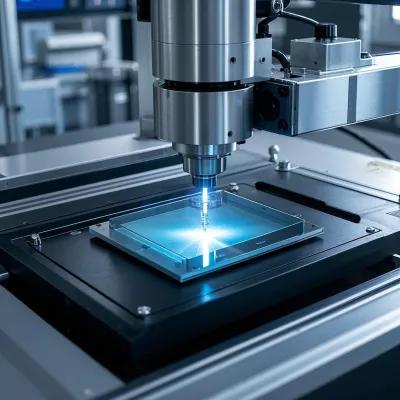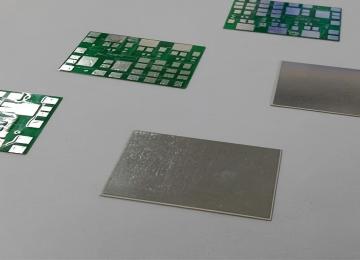
News
How Does an Ultraviolet Picosecond Laser Marking Machine Break Through Precision Processing Bottlenecks?
In the era of smart manufacturing, laser processing technology has become a core engine driving industrial upgrading. As an innovative representative in the laser equipment manufacturing sector, an ultraviolet picosecond laser marking machine developed by a leading enterprise is leading a revolution in high-precision processing. This article will analyze how this equipment helps enterprises improve production efficiency and product quality from the perspectives of technical principles, application scenarios, and industry value.
I. Ultraviolet Picosecond Laser Marking Machine: A Technological Breakthrough in High-Precision Laser Processing
The ultraviolet picosecond laser marking machine employs a 355nm ultraviolet laser and achieves micron-level spot focusing through three-stage intracavity frequency doubling technology. Its core advantage lies in its "cold processing" characteristic: The ultrashort pulse width (<15ps) laser energy breaks molecular bonds in materials through photochemical ablation, avoiding thermal deformation and material damage common in traditional laser processing. This non-thermal processing principle enables the device to achieve burr-free and crack-free fine marking on the surfaces of various materials, including metals, glass, ceramics, and plastics.
The technological leadership of this equipment is reflected in:
1. Ultra-fine engraving capability: With a focused spot diameter reaching the micron level, it can clearly carve tiny text, complex patterns, and high-density QR codes, meeting the stringent requirements for high-precision marking in industries such as electronics and medical devices.
2. High-efficiency production performance: The laser repetition frequency can reach up to 4000kHz. Combined with an intelligent scanning system, it significantly accelerates marking speed, helping enterprises achieve large-scale production.
3. Wide material adaptability: Whether it is deep engraving on metal components or damage-free processing of brittle materials like glass and sapphire, the equipment can stably output high-quality marks.
II. Five Application Scenarios: How Does the Ultraviolet Picosecond Laser Marking Machine Empower Different Industries?
1. Electronics and Semiconductor Industry
In PCB circuit board production, the ultraviolet picosecond laser marking machine can precisely engrave component serial numbers and traceable QR codes through visual positioning technology, while its low thermal impact ensures no damage to circuit board performance. Its micro-spot technology is particularly suitable for fine marking on chip packages, providing a reliable solution for the semiconductor industry.
2. Medical Device Manufacturing
The medical field has strict requirements for the safety and traceability of devices. This equipment can engrave permanent and wear-resistant marks on the surfaces of metal medical instruments such as scalpels and implants, meeting medical-grade standards. It also supports the processing of complex patterns and hidden anti-counterfeit marks.
3. Automotive Parts Processing
Critical automotive components (such as engine numbers and airbag sensors) require durable and clear identification. The high-energy density characteristics of the ultraviolet picosecond laser marking machine enable the formation of uniformly deep and corrosion-resistant marks on metal surfaces, satisfying the dual needs of the automotive industry for mark durability and aesthetics.
4. High-End Consumer Goods and Optical Devices
For glass back covers and sapphire lenses of smartphones and smartwatches, the equipment can achieve damage-free engraving, easily completing the processing of LOGOs, QR codes, and other patterns, enhancing the high-end texture and brand recognition of products.
5. Food and Pharmaceutical Packaging
Ultraviolet lasers can mark plastic and glass packaging without ink, complying with food safety standards. They also ensure the clarity and durability of information such as production dates and batch numbers, helping enterprises improve their traceability systems.
III. Industry Value: How Does the Ultraviolet Picosecond Laser Marking Machine Drive Manufacturing Upgrades?
The high precision and flexibility of the ultraviolet picosecond laser marking machine bring multiple values to enterprises:
Improving product quality: Cold processing technology avoids material damage, ensuring clear and durable marks and enhancing product competitiveness.
Reducing production costs: High-speed marking and intelligent control reduce manual intervention and improve production efficiency.
Expanding application boundaries: The ability to adapt to various materials helps enterprises explore new markets and product lines.
Conclusion
The ultraviolet picosecond laser marking machine is becoming a key device for manufacturing upgrades. Its advanced technical characteristics and broad applicability provide enterprises with a shortcut to high-precision processing. With continuous innovation in laser technology, this equipment will continue to drive industries toward more efficient and precise development.
-
What are the precautions for operating a laser marking machine?
1. It is strictly prohibited to start the laser power supply and Q-switching power supply when there is no water or the water circulation is abnormal.
2. The Q power supply is not allowed to operate without load (i.e., the output terminal of the Q power supply should be left floating).
3. In case of any abnormal phenomenon, first turn off the galvanometer switch and the key switch, and then conduct a check.
4. It is not allowed to start other components before the krypton lamp is lit to prevent high voltage from entering and damaging the components.
5. Pay attention to leaving the output terminal (anode) of the laser power supply suspended to prevent sparking and breakdown with other electrical appliances.
6. Keep the internal circulating water clean. Regularly clean the water tank and replace it with clean deionized water or pure water.
-
What should we do when laser intensity decreases and the marking is not clear enough?
1. Turn off the machine and check if the laser resonant cavity has changed; Fine-tune the resonant cavity lens. Make the output light spot the best;
2. The acousto-optic crystal is offset or the output energy of the acousto-optic power supply is too low;
Adjust the position of the audio-visual crystal or increase the working current of the audio-visual power supply;
3. The laser entering the galvanometer deviates from the center: Adjust the laser;
4. If the current is adjusted to around 20A but the light sensitivity is still insufficient: the krypton lamp is aging. Replace it with a new one.
-
How to maintain a UV laser cutting machine?
1. It is required to carry out regular cleaning every day, remove debris from the countertop, limiters and guide rails, and spray lubricating oil on the guide rails
2. The waste materials in the collection box should be cleared regularly to prevent excessive waste from blocking the exhaust port.
3. Clean the chiller once every 15 days, drain all the internal water, and then fill it with fresh pure water.
4. The reflector and focusing lens should be wiped with a special cleaning solution every 6 to 8 hours.
When wiping, use a cotton swab or cotton swab dipped in the cleaning solution to wipe from the center to the edge of the focusing lens in a counterclockwise direction.
At the same time, be careful not to scratch the lens.
5. The indoor environment can affect the lifespan of the machine, especially in damp and dusty conditions.
A damp environment is prone to causing rust on the reflective lenses and also easily leading to short circuits, discharge and sparking of the velvet laser.
-
What accidents might be caused by the laser emission when using a laser cutting machine?
(1) A fire was caused by the laser coming into contact with flammable materials.
Everyone knows that the power of laser generators is very high, especially when it comes to high-power laser cutting machines, the temperature of the emitted laser is extremely high. The possibility of a fire being caused when a laser beam comes into contact with flammable objects is very high.
(2) Harmful gases may be produced when the machine is in operation.
For instance, when cutting with oxygen, it undergoes a chemical reaction with the cutting material, generating unknown chemical substances or fine particles and other impurities. After being absorbed by the human body, it may cause allergic reactions or discomfort in the lungs and other respiratory tracts. Protective measures should be taken when conducting work.
(3) Direct laser exposure to the human body can be harmful.
The damage caused by lasers to the human body mainly includes damage to the eyes and skin. Among the harms caused by lasers, the damage to the eyes is the most severe. Moreover, damage to the eyes is permanent. So when doing homework, you must pay attention to protecting your eyes.
-
What is the focused spot diameter of nanosecond, picosecond and femtosecond laser?
Nanosecond: The light spot is 0.5-1mm.
Picosecond: The focused spot is around 0.02mm.
Femtosecond: Under the action of a laser beam with a high repetition rate of 100-200KHz and a very short pulse width of 10ps,
the focused spot diameter is as small as 0.003mm.
-
What are the main applications of UV laser cutting machine?
The UV laser cutting machine can be used for cutting and depaneling PCB.
It can precisely cut and shape various types of PCB circuit boards with V-CUT and stamp holes, and open Windows and covers.
It can also be used for separating packaged circuit boards and ordinary smooth boards.
It is suitable for cutting various types of PCB substrates, such as ceramic substrates, rigid-flex boards, FR4, PCBs, FPCs, fingerprint recognition modules, cover films, composite materials, copper substrates, aluminum substrates, etc.
-
Precautions for laser cutting machines to process various metal materials?
Copper and brass:
Both materials have high reflectivity and excellent thermal conductivity.
Brass with a thickness of less than 1mm can be processed by nitrogen laser cutting.
Copper with a thickness of less than 2mm can be cut. The gas used for laser cutting processing must be oxygen.
Copper and brass can only be cut when a "reflective absorption" device is installed on the system. Otherwise, reflection will damage the optical components.
Synthetic materials:
Processable synthetic materials include: thermoplastics, thermosetting materials and artificial rubber.
Aluminum:
Despite its high reflectivity and thermal conductivity, aluminum materials with a thickness of less than 6mm can be cut, depending on the type of alloy and the capacity of the laser.
When cutting with oxygen, the cutting surface is rough and hard.
When nitrogen is used, the cutting surface is smooth.
Pure aluminum is extremely difficult to cut due to its high purity.
Only when a "reflection and absorption" device is installed on the fiber laser cutting machine system can aluminum materials be cut.
Otherwise, reflection will damage the optical components
-
What should be paid attention to when laser cutting stainless steel?
Laser cutting processing of stainless steel requires the use of oxygen, under the condition that edge oxidation is not a concern.
If nitrogen is used to achieve an edge free of oxidation and burrs, no further processing is required.
Coating an oil film on the surface of the sheet will achieve a better perforation effect without reducing the processing quality.






